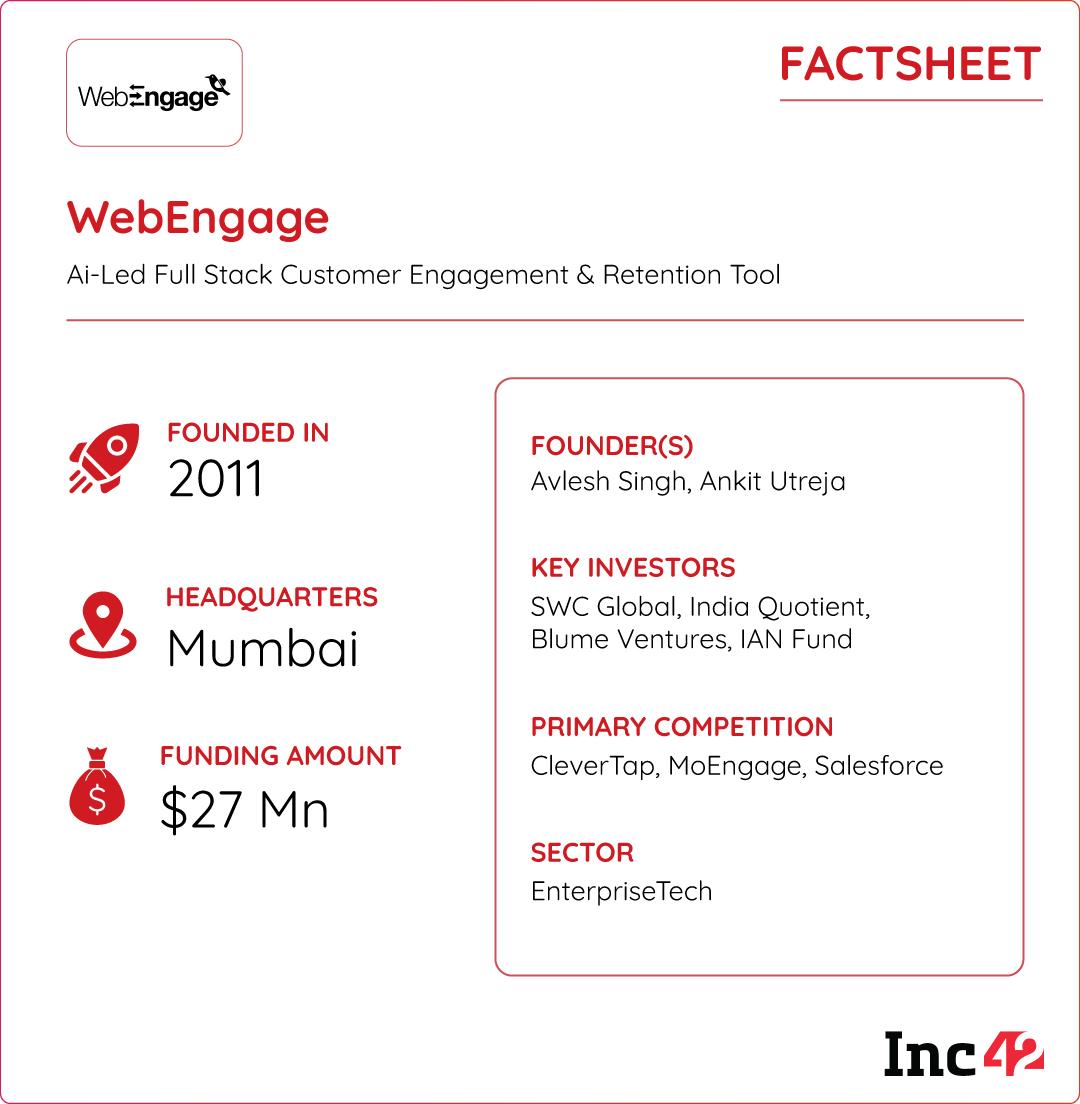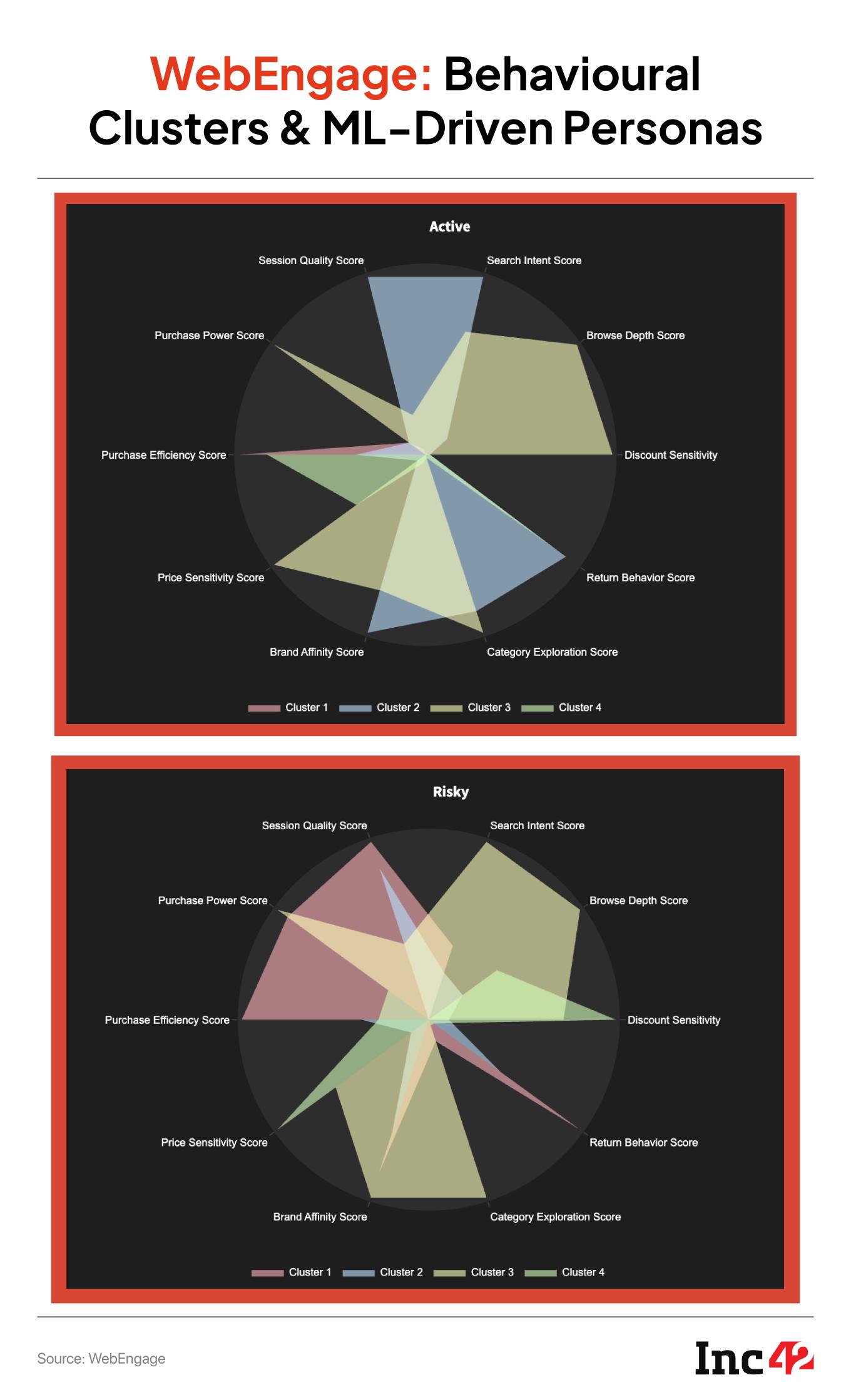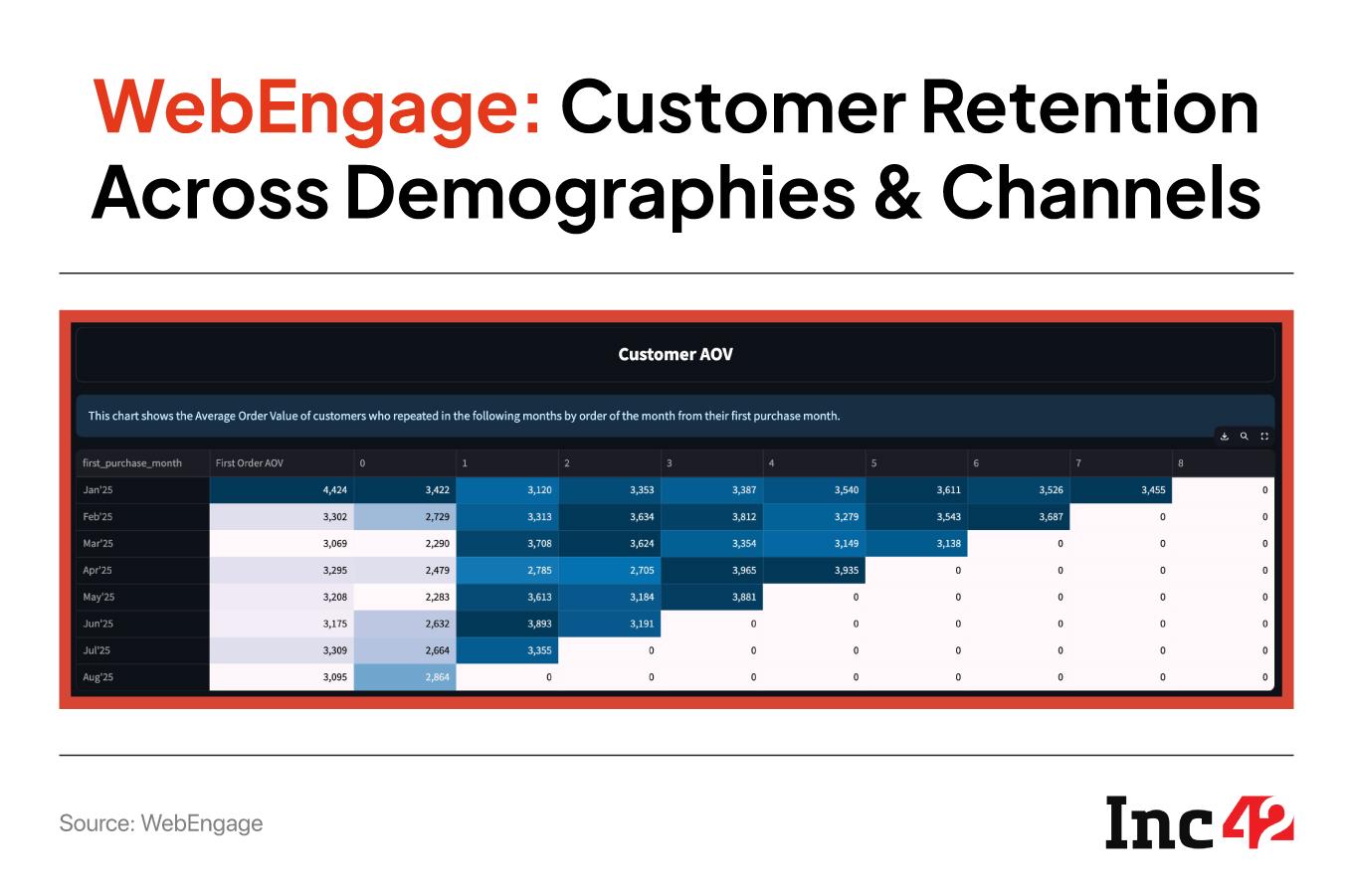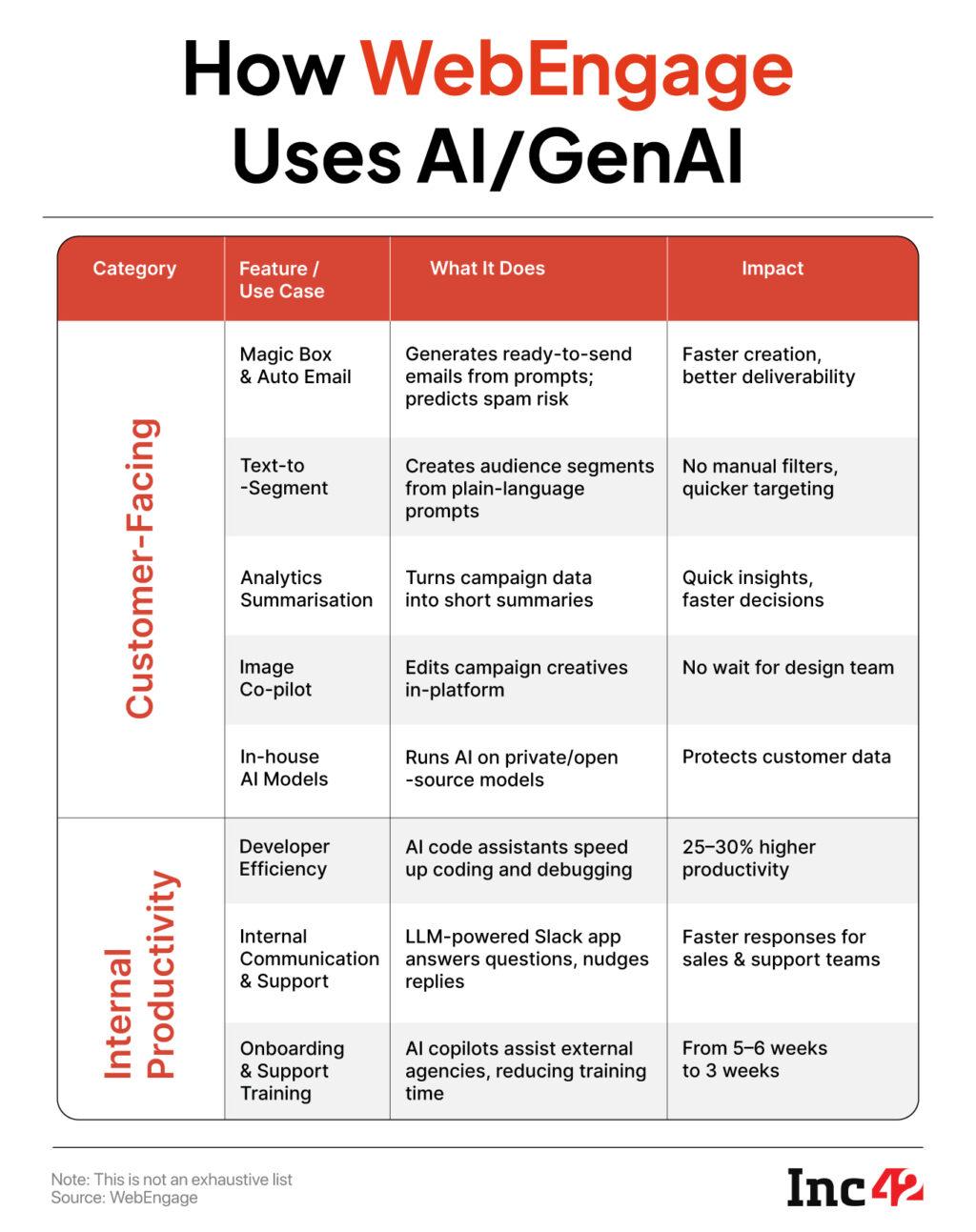By the early 2020s, AI stopped being a side experiment in martech, and became central to how businesses engaged, retained, and understood their customers.
WebEngage got the early whiffs of the change and rebuilt its platform for a new age of customisation where data intelligence would derive every decision. The Mumbai-based enterprise technology solutions provider evolved into a full-stack engagement and retention platform, capable of handling the next wave of data-heavy, decision-led martech use cases.
Today, WebEngage serves over 900 businesses across ecommerce, travel, fintech, insurance, utilities, and other sectors with a team of more than 375 people. India remains its largest market, fetching around 50% of the revenue, while the Middle East contributes around 30%.
“We are growing profitably. Our annual recurring revenue (ARR) has grown from $3,000 in FY16 to over $22.8 Mn in FY25 and we are aiming for $34.2 Mn (INR 300 Cr) ARR in FY26,” said cofounder and CTO Ankit Utreja. The company had raised $20 Mn in its Series B round in August 2022.
What began as a marketing automation tool in 2011, evolved into a horizontally scalable system with AI and GenAI-led products spanning data processing, decision automation, personalisation, and cross-channel orchestration.
WebEngage upgraded its customer data platform CDPX to let businesses bring their own data models and schemes into the system. It was a necessary step, given that marketing automation depends on clean, structured, and relevant data.
The company deepened its engagement capabilities to personalise app and website content for each user in real time, drawing on browsing history and behavioural data. This shift has also taken it beyond pure marketing into more direct product use cases.

Engineering graduates Avlesh Singh and Ankit Utreja worked together at Burrp.com, a foodtech startup around 2010. Incorporated in 2006, Burrp was one of the early online platforms offering restaurant discoveries, deals, and reviews.
The duo was tasked to find solutions to display contextual messages or advertisements to Burrp website visitors. They realised that user engagement in general was quite agnostic. Based on their experience in Burrp, they rolled out WebEngage in 2011 with an initial beta version – a very simple SaaS-based tool to allow any website owner to take actions on their users and visitors on a real-time basis.
“Most businesses then relied on free analytic dashboards to track user behaviour, where traffic came from, which sections users engaged with, when they dropped off, or how quickly they left a page,” Utreja recounted. “But, there were no tools to act on those behaviours in real time.”
That gap, he noted, became the team’s first problem statement: enabling site owners to intervene, nudge, and guide users when it mattered most.
Between 2011 and 2014, WebEngage transitioned from a basic nudge engine to a conversion rate optimisation (CRO) platform aimed at improving website funnel performance. As smartphone usage increased and customer communication shifted to push notifications and in-app messages, the company began to focus on user retention.
WebEngage launched Journey Builder, a visual tool for brands to create automated, logic-driven user flows across digital touchpoints, in 2015-16. The approach worked on individual user behaviour patterns. If a user, for instance, installed the app, but did not open it for two days, a push notification would be sent. If there was no response, an SMS would follow a couple of days later. This created a personalised, one-to-one communication flow where each user moved at their own pace.
“That was a drastic shift. It gave us an edge as it was a novel idea in the B2C marketing landscape. From then on, I think, the commercial success of the company started to get redefined,” Utreja said.
The company then began developing its Customer Data Platform (CDP), allowing clients to consolidate behavioural data, segment audiences, and trigger personalised actions from a unified system. This marked a shift from rule-based nudges to real-time, data-driven engagement and helped WebEngage reposition itself as a high-engagement, enterprise-grade platform.
Being a horizontal platform serving a range of industries, WebEngage faced various complexities, with the limits of human-led decision-making in large-scale personalisation becoming more evident. “If you have a 10 Mn-strong user base and have to send 10 campaigns, you’re sitting on 100 Mn data points. It is humanly impossible to process that and decide what worked, what didn’t, or what should be done next,” Utreja said.
That’s where the company’s AI journey began.

WebEngage started experimenting with AI in 2018. Commercial AI in marketing was still centred on machine learning (ML), not large language models (LLMs). Predictive analytics, recommendation engines, and rule-based automation were industry standards. Even companies like Google and Amazon were applying AI mainly to product recommendations, search relevance, and ad targeting.
WebEngage started using ML in campaign decisions on behalf of marketing operators, helping them with hundreds of micro-decisions without relying on a mix of data and intuition. “Many of our early AI features came from operators asking some simple questions. But, when we connected them, we realised they all sat under the same product umbrella,” Utreja said.
When to send? WebEngage noticed that the operators often chose a time they believed worked best for their brand, and sent out the communication. But user behaviour varied widely – some read messages over the weekend, some during lunch breaks, and some late at night. Determining the right time for each user required experiments and pattern analysis, which led to the development of ‘Best Time to Send’. The feature analyses each user’s engagement history and determines the optimal send time, removing guesswork and manual testing.
Which channel to use? Channel preference also varied. One user might respond better to a push notification, another to an email, and another to an SMS. In the past, some customers had even built their own algorithms to find the optimal channel. This became the basis for ‘Best Channel’, which uses the customer’s own data to make channel recommendations without cross-tenant data sharing.
Who to send to? Audience targeting posed another challenge. An operator might define a segment like people in Pune and Delhi never purchased or acquired in the last 30 days. This narrowed the audience, but didn’t answer who in that group was most likely to respond. The team developed features that suggest sub-segments with higher engagement potential based on past campaign results.

Over time, these AI-driven features became core to how WebEngage helps marketing operators reduce decision fatigue and improve campaign performance. “If you send 100 emails, the average open rate might be 20–30%, if you’re B2B. If you’re B2C, it could be as low as 1–2%,” Utreja said.
Optimising the timing, channel, and content not only improved customer engagement, but also reduced the cost of sending campaigns, which is especially important when 97% of messages could go unopened. “Also, they [clients] didn’t have to make every decision themselves – the system could suggest options, and they could simply approve the ones that worked.”
Getting Deeper Into ML ModelsMachine Learning models need historical data to understand user behaviour, creating a ‘cold start’ issue for new customers. As a first-party CDP, WebEngage kept each customer’s data isolated, so algorithms could only learn from that dataset.
“If a healthcare company is using it, a user becomes a patient. If an ad tech company is using it, the user could be a parent, a teacher, or a student. Churn is a problem for everyone, but it’s different for a subscription business versus an ecommerce store, grocery, or travel company,” Utreja explained.
These variations meant the same predictive model couldn’t work for all customers. To solve these challenges, the team built vertical cuts tailored to each industry, product type, and user behaviour. One of the core steps in this direction was the acquisition of pune-based Propellor.ai in April 2024 and the subsequent launch of WebEngage Black.
How Webengage strengthened its ML-led AI product suite? Let’s try to comprehend.
Integrating Propellor.ai: Propellor was solving two types of problems. For smaller ecommerce players, it offered analytics that uncovered low-hanging growth opportunities, helping them optimise critical metrics like ROAS (return on ad spend). For businesses, it built tools for creating a 360-degree customer view – mapping campaigns, profiling, transactions, acquisition channels, and customer journeys.
Launching WebEngage Black: Propellor’s small, specialised team helped customise solutions for enterprise needs as WebEngage continued to scale its horizontal SaaS platform. This partnership seeded a new product, WebEngage Black, designed to layer ML and AI on top of the core platform, delivering vertical-specific intelligence.
Launching Magic Block: In July 2024, WebEngage introduced Magic Block, an AI-powered upgrade to its Journey feature, which is a visual canvas where marketers design flow-based communication strategies. The company saw every user was different. Some could be reached by emails, some preferred push notifications, while others were in favour of SMSes. The number of possible combinations across channels, timings, and preferences was too large to map on a canvas. Magic Block solved this.
Launching Significant Factors: In 2025, WebEngage rolled out Significant Factors for business owners who wanted to go beyond surface-level funnel metrics. On the platform, an ecommerce operator, for example, can create a visual funnel like Product Page → Add to Cart → Checkout → Complete Purchase. If 100 people enter the funnel, the average might show that only 3.5% complete the last step. But, in reality, there are subgroups or slices. Some might convert at 7–10%, while others drop to just 0.5%. AI/ML runs the combinatorial analysis in 10–20 minutes instead of days, automatically surfacing the best and worst performing segments.
The payoff is huge. “If I know a segment is converting at 0.5%, I can stop acquiring those users and focus my budget on the 7–10% converters. That directly improves ROAS,” Utreja pointed out.

As Utreja explained, it was only from 2023 that WebEngage began introducing solutions based on LLMs and AI. The approach was not about simply embedding a public model like OpenAI’s into the platform, but about integrating these models into workflows running on WebEngage.
“In a B2B setup and a production-grade system, you can’t just build a wrapper on OpenAI and go to market. Because all the operators have OpenAI, Gemini, OpenMIP and the print app,” he said. “There’s no value to it. The value only comes from what the operator can’t do. And what they really can’t do is give the entire feedback, the context to the LLM.”
That context came from years of historical campaign data, operator behaviour patterns, and outcome histories that offered insight into how operators work and what results they’ve seen. Feeding that into an LLM made responses more relevant and reduced the need to start from scratch.
This also powered smaller, but high-impact features, like SMS length optimisation. SMS campaigns have a simple but costly quirk – going beyond 160 characters results in billing for multiple messages. Operators know this in theory but rarely put in the effort to manually trim every message.
Using an LLM, WebEngage could condense long messages without losing on communication. For high-volume campaigns, the cost impact was significant. If one SMS costs 10 paise, a 200-character message would be billed as two, doubling the cost. A three-paragraph message could easily cost 30 paise per send. For a campaign reaching 10 Mn recipients, the savings from optimising length could be massive.
The same approach extended to WhatsApp, where messages are free but come with their own rules. In B2B marketing, every WhatsApp message must follow a pre-approved template. WebEngage’s AI can generate multiple variations of a single approved template, and ML models track which one performs best.
“We allow people to not only generate one message, but create six variations. The system will automatically see over a period of time what kind of variation is working.”
Since most campaigns are long-running and trigger-based, the system typically starts favouring the top-performing variation around day 16, once enough data has come in. With LLMs, language is also no barrier. The only requirement is that operators know English to work the dashboard.

The $22.34 Bn global customer engagement solutions market is likely to reach $48.51 Bn by 2032 at an annual growth rate of 10.3%. This is backed by a $6.45 Bn marketing automation software market that’s projected to scale $16.81 Bn at a CAGR of 12.8%.
India claims a substantial chunk of this market. WebEngage faces competition from a host of players like MoEngage, CleverTap, Brevo (formerly Sendinblue), Intercom, and Zoho SalesIQ.
Other noted competitors in this space include the likes of Braze, Netcore, Insider, and Adobe Experience Cloud, which also offer overlapping capabilities in multichannel messaging, personalisation, and campaign automation.
As WebEngage raced down this fast lane, sourcing talent turned out to be a key problem. On the machine learning side, there are plenty of out-of-the-box solutions such as TensorFlow and SageMaker. “Applying these out-of-the-shelf models in their own ways is a very costly problem for us. And in ML, it’s not ‘I know the problem, I have the solution, let’s solve it’. It’s generally an iterative journey.”
That means they need to break problems down in ways that might not look like what’s described online, bringing in their own assumptions and constraints. That calls for people who can think differently. “Finding that skill set is tough. You can get 100 AI data scientist CVs, shortlist a bunch, but very few will know how to solve this kind of problem in a non-traditional way,” said Utreja.
When it comes to GenAI, it’s tempting to look at a feature, see how well it works, and just package it up. But in B2B, the risks are bigger. “Whatever ROI we see, we also need to compare it with the risk. The risk-reward ratio needs to be very, very clear,” he said.
Thrashing Out The Blueprint For FutureWebEngage deals with a lot of customer data – running into terabytes – and it aims to use this data to create an autopilot option for marketing with AI, precisely GenAI, while continuing the core machine learning work.
“Wherever there are humans in the loop right now, someone needs suggestions about what to do next, someone just needs assistance,” said Utreja.
The idea is not to remove people but to reduce the time and effort needed for common tasks. If a question can be answered in 20 minutes, instead of two days, that’s progress. Talent shortages in marketing and engineering make it even more important for systems to understand the business context on their own and then suggest the next steps. This is where WebEngage sees itself as a co-pilot for marketers and operators.
Utreja also believes that on the revenue side, AI is valuable but hasn’t yet created a big jump in ticket sizes. Once automation truly runs on autopilot, there may be room for significant premiums, but for now, the impact is incremental.
“The moment we reach a place where marketing automation is really on autopilot, that’s where you can come on 100% premium or more than that. Otherwise, it is still going to be incremental,” he said.
The company is also focussed on investing in vertical AI through WebEngage Black, while strengthening its horizontal platform, where its CDPX product is expected to play a major role. For FY26, the focus is on scaling CDPX and WebEngage Black in India and the Middle East, and then expanding into Southeast Asia, Latin America, and Europe.
[Edited by Kumar Chatterjee]
The post Can WebEngage Power Martech’s Next Phase With Its GenAI Play? appeared first on Inc42 Media.
You may also like

29 districts in Raj, 19 in Punjab hit by overexploitation of groundwater: MoS

Man Utd's Alejandro Garnacho exit plan halted by transfer refusal

Donald Trump vows to 'get rid' of voting machines as he repeats 'voter fraud' claims

List of 13 OTT titles premiering this week [August 18 and 24, 2025]

New ultrasound drug delivery safe, reduces side effects






